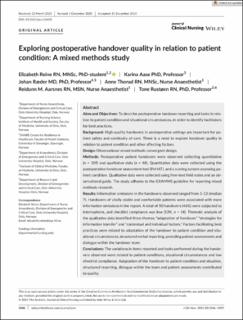| dc.contributor.author | Reine, Elizabeth | |
| dc.contributor.author | Aase, Karina | |
| dc.contributor.author | Ræder, Johan | |
| dc.contributor.author | Thorud, Anne | |
| dc.contributor.author | Aarsnes, Reidunn M. | |
| dc.contributor.author | Rustøen, Tone | |
| dc.date.accessioned | 2023-02-23T08:22:33Z | |
| dc.date.available | 2023-02-23T08:22:33Z | |
| dc.date.created | 2021-06-08T12:45:34Z | |
| dc.date.issued | 2021 | |
| dc.identifier.citation | Reine, E., Aase, K., Ræder, J., Thorud, A., Aarsnes, R. M., & Rustøen, T. (2021). Exploring postoperative handover quality in relation to patient condition: A mixed methods study. Journal of Clinical Nursing, 30(7-8), 1046-1059. | en_US |
| dc.identifier.issn | 0962-1067 | |
| dc.identifier.uri | https://hdl.handle.net/11250/3053462 | |
| dc.description.abstract | Aims and Objectives
To describe postoperative handover reporting and tasks in relation to patient condition and situational circumstances, in order to identify facilitators for best practices.
Background
High-quality handovers in postoperative settings are important for patient safety and continuity of care. There is a need to explore handover quality in relation to patient condition and other affecting factors.
Design
Observational mixed methods convergent design.
Methods
Postoperative patient handovers were observed collecting quantitative (n = 109) and qualitative data (n = 48). Quantitative data were collected using the postoperative handover assessment tool (PoHAT), and a scoring system assessing patient condition. Qualitative data were collected using free-text field notes and an observational guide. The study adheres to the GRAMMS guideline for reporting mixed methods research.
Results
Information omissions in the handovers observed ranged from 1–13 (median 7). Handovers of vitally stable and comfortable patients were associated with more information omissions in the report. A total of 50 handovers (46%) were subjected to interruptions, and checklist compliance was low (13%, n = 14). Thematic analysis of the qualitative data identified three themes: “adaptation of handover,” “strategies for information transfer” and “contextual and individual factors.” Factors facilitating best practices were related to adaptation of the handover to patient condition and situational circumstances, structured verbal reporting, providing patient assessments and dialogue within the handover team.
Conclusions
The variations in items reported and tasks performed during the handovers observed were related to patient conditions, situational circumstances and low checklist compliance. Adaptation of the handover to patient condition and situation, structured reporting, dialogue within the team and patient assessments contributed to quality.
Relevance to clinical practice
It is important to acknowledge that handover quality is related to more than transfer of information. The present study has described how factors related to the patient and situation affect handover quality. | en_US |
| dc.language.iso | eng | en_US |
| dc.publisher | Wiley | en_US |
| dc.rights | Navngivelse 4.0 Internasjonal | * |
| dc.rights.uri | http://creativecommons.org/licenses/by/4.0/deed.no | * |
| dc.title | Exploring postoperative handover quality in relation to patient condition: A mixed methods study | en_US |
| dc.type | Peer reviewed | en_US |
| dc.type | Journal article | en_US |
| dc.description.version | publishedVersion | en_US |
| dc.rights.holder | The authors | en_US |
| dc.subject.nsi | VDP::Medisinske Fag: 700 | en_US |
| dc.source.pagenumber | 1046-1059 | en_US |
| dc.source.volume | 30 | en_US |
| dc.source.journal | Journal of Clinical Nursing (JCN) | en_US |
| dc.source.issue | 7-8 | en_US |
| dc.identifier.doi | 10.1111/jocn.15650 | |
| dc.identifier.cristin | 1914483 | |
| cristin.ispublished | true | |
| cristin.fulltext | original | |
| cristin.qualitycode | 2 | |

